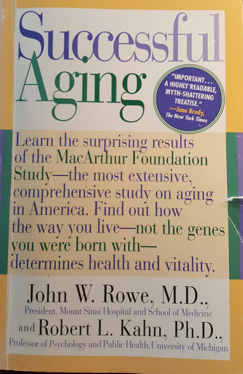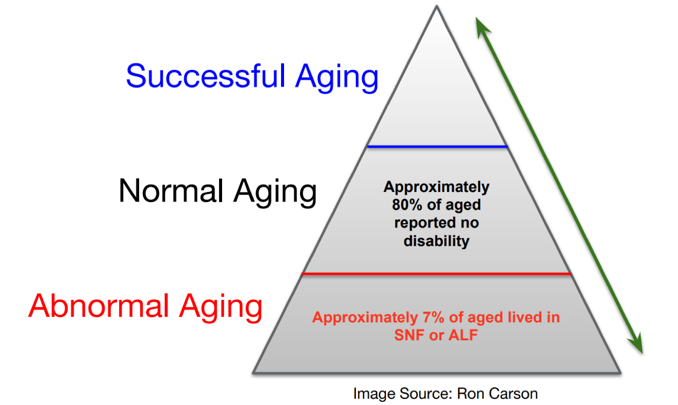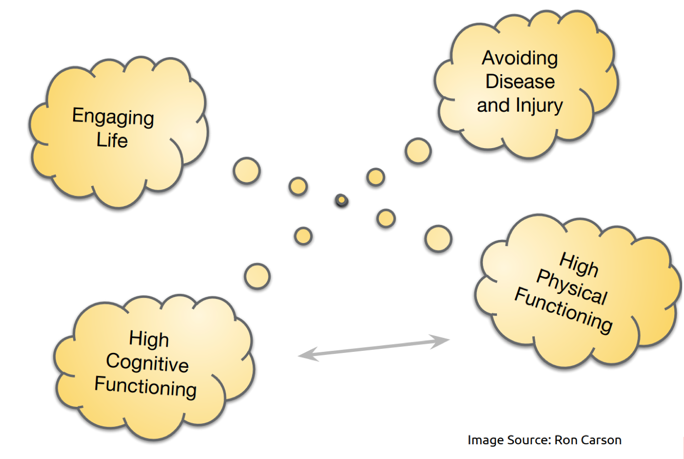Ron: Well, thank you for that nice introduction.
Introduction
The concept of successfully aging is a relatively new concept. I have had this book for about 20 years (Figure 1).

Figure 1. Successful Aging book, published in 2008.
As a matter of fact, I bet that most people in the audience have never really heard of the concept or the theory of successful aging. It has been around for a while, but it is not receiving more attention. It looks at how people can grow old more successfully. I would put myself in that category as I am 57 years old. I am not old by most standards, but I am getting there.
I want to start off with a quote.
It is not by muscle, speed, or physical dexterity that great things are achieved, but by reflection, force of character, and judgment; in these qualities old age is usually not only not poorer, but is even richer.
Cicero (44 B.C.)
Look when this statement was written, in 44 years before Christ's birth. Cicero was a Roman philosopher, and he is summarizing what growing old can be like. It is not about our physical body, cognitive body, or anything else, but rather, it is about the summation of everything. I think that is really an important concept. It is about achievement as well.
Case Application
Here is a case application. I want to share this in the beginning, and then we are going to come back and view it again at the end. As we are going through some of this information, I want you to refer back to this information.
78 y/o woman being seen in the home secondary to hip fx who fell while rock climbing. No additional injuries. The patient is depressed since her accident. Now, shows fear of falling during mobility-related ADL’s. Reluctant to participate in OT.
I assume most people in the audience are either working with older adults, have older parents, or are interested in older adults. I have never actually had a 78-year-old rock climbing patient, but I wanted to use this as an example. The '70s are the new 50's.
Ways to Age
People are aging, in general, a lot better. I want to now talk a little bit about aging in general, and then I am going to talk a little bit about what is it like to normally age. Then, we are going to get into the meat of tonight's presentation which is successfully aging. The one thing that I am not really going to talk about at all is abnormal aging. Let me talk a little bit about this pyramid that I put together in Figure 2.

Figure 2. Ways to age.
I have been practicing for over 20 years now. I always thought that with aging populations that the older we got, the sicker we got. And the sicker we got, the more infirm we got. And the more infirm we became, the greater the chance of institutionalization.
Getting statistics and information on growing old is very challenging. For every statistic that you find that says, "A," you will find another statistic that says "B and C." There is no good way to get a really distinct handle on aging statistics. So, take these numbers with a grain of salt. You can always find data that goes against it. However, the numbers are not really what is important. Most people tend to think that everybody, as they grow old, is really sick. But, most people are not sick to the degree that they end up being institutionally placed. This is only a small percentage, less than 10% of older adults. Of course, this number is going to go up a little bit as this age cohort increases, but it is still a relatively small number.
At the top of this pyramid is successful aging. There was no statistical data on successful aging that I could find because successful aging is a relatively new theory being talked about. The largest percentage is found in the normal aging category. They are not climbing mountains, but they are also not infirm. What we are going to talk about is successfully aging and normal aging.
Definitions
- Successful Aging is the process of aging while avoiding disease, engaging in life, and staying active.
- Normal Aging is the process of normal age-related changes and the probability of disease-related changes.
- Abnormal Aging is the presence of age-related changes and abnormal diseases, conditions, and syndromes.
Successful aging is the process of engaging in life and staying active while avoiding disease. I will point out a little bit later why those three things support successful aging. Normal aging is the process of normal age-related changes and the probability of age-related diseases in a few moments. For example, you might think of macular degeneration as being age-related, but it is not caused by age. It is just related to older adults.
Abnormal aging is the presence of age-related diseases and changes. This is normal aging, plus abnormal diseases and conditions. There are successful agers who tend to avoid diseases and stay very active. I hate to use that word abnormal. That is a word I made up to describe people who grow old and then have a lot of diseases. Typically, we work with people that have abnormal aging.
Let's talk real quick about normal age-related changes. This is a review as I did a course on Normal Aging a few weeks ago. Again, these are things that happen to us, all of us, as we grow old, and there is really just nothing you can do about it as far as preventing them.
- Physical
- Decreased cardiovascular-pulmonary function
- Decreased muscle mass
- Decreased flexibility
- Increased body fat
- Decreased visual acuity
- Cognitive
- Decreased processing speed
- Decreased new learning potential
- Socio-Cultural
- Loss of role identity
- Increasing isolation
We certainly can slow down the normal aging process, but it is impossible, as far as we know at this point in our lives, to stop the aging process. Everything that is flexible as you get older will become less flexible. Everything that is rigid now, as you get older, will become less rigid. Your heart, which is typically very pliable and pumps a lot of blood, becomes much more rigid and pumps less blood as you age. It is not an effective machine at this point and has to work harder. Our bodies are biomechanical machines, and like any machine, with age, it tends to wear out.
The medical term for age-related loss muscle mass is sarcopenia. Exercise can help reduce the loss of muscle mass in the degree and speed, but it does still happen. We all get more fat, and that can be a challenge as well. Our cardiovascular metabolism slows down, and our vision gets worse, especially around 40 years old.
For cognitive changes, people do not lose executive functioning or their ability to carry out complex processes. It just takes longer. The speed at which processing occurs is slower with age. An older person can learn to use a computer, but it is just going to take a lot more time than it would for a younger person to learn to use a new computer. If you have a patient that is aging normally and they have a hip fracture, it might take them longer to remember the hip precautions. Their new learning is decreased because their cognitive processing speed is decreased as well. Finally, there can be increased isolation and a loss of role identity. These are really important issues that help to age people a lot quicker. As we age, people around us begin to die at an increasing rate of speed.
Successful Aging
Here is another quote from the book I showed originally.
Successful aging goes beyond potential; it involves activity.
(Rowe & Kahn, 1997)
The two authors are a medical doctor named Rowe and a PhD named Kahn. I, personally, would use the word occupation in there. We could summarize this whole presentation by saying, "successful aging requires occupational performance." We must do, be engaged, and produce things to successfully age. Think about all the patients you have worked with, all the patients you are going to work with, and how the concepts of success aging plays out in your treatment. There is a lot of application that can come from understanding successful aging. I want to start off first talking again about successful aging and about the controversy of successful aging.
Controversy
- Defining successful
- No singular agreed upon definition
- The personal impact of not being successful
- Societal expectations versus personal expectations
- Who determines successful and how?
- One study shows certain ethnicities age less successfully (Wada, Mortenson, & Clarke, 2016).
- Stereotyping - is it ever good?
- “Standards for successful aging reflect value judgments that are culturally and historically situated” (Angel et al., 2018).
There are many definitions of successful aging. The authors came up with their own definition, but there are many other definitions of what successful aging is. The first problem is who defines what is successful? There is no single definition that says what is successful. It is like occupation. There are a dozen different definitions of occupation, but there is no single, unified definition of what occupation is or is not. What is successful for one person might not be successful for the next person.
What is the impact of not being successful? This is my opinion, but if somebody is in a social group and everybody around them is successful but them, how does that make them feel? Does that make them feel less worthy or less valuable because they are not as successful as the people around them? When we start labeling, there is always a subgroup of people who are outside of that. By definition, they feel they are not successful. I think that is something for us to be concerned about.
There are also societal expectations versus personal expectations. We are going to talk about societal expectations. What if my definition of success is very different than the authors' definitions of successful? Does that mean I am not successful? Is it what society says is successful, or is it what I say is successful? One study by Wada, Mortenson, and Clarke (2016) showed that certain ethnicities age less successfully. If there is an ethical or a racial component to successfully aging, what if you do or do not fall into that?
There are all sorts of stereotyping that goes on with being successful. Another author stated that standards for successful aging reflect value judgments that are culturally and historically situated (Angel et al., 2018). What is successful today may not be successful tomorrow. As soon as you start trying to define it, you end up with all sorts of problems.
History
- 1960s - Life Satisfaction, (Neugarten, Havinghurst & Tobin, 1981)
- Life Satisfaction Inventory Aging Scale
- 1997 - Successful Aging, (Rowe & Kahn, 1997)
- 2011 - Successful Aging Inventory (Troutman, Nies, Small, & Bates, 2011)
The history of successful aging is fairly short. In the 1960s, three researchers, Neugarten and Havinghurst and Tobin, completed a study on life satisfaction. This was the beginning of a psychological trend at looking beyond what is wrong with aging and looking at how people age successfully. How do people define life satisfaction? Then in 1997, Kahn and Rowe came along with their study that resulted in the book I shared earlier. Lastly, in 2011, there was the Successful Aging Inventory. This was developed as a way to measure successful aging.
Again, this is a relatively new concept about what successful aging is. Figure 3 shows a picture of a Jeanne Calment. I used her in an earlier presentation. At one time, she was considered the oldest living person in the world. She loved sugar, smoked (not very much) and had an active lifestyle. When she was 100 years old, she broke her leg. When she was114, she fell and broke her leg again. This was the beginning of the end for her.
Interestingly, after I did this presentation last time on normal aging and included this slide, I happened to come across a new story that said that most of what was known about Jeanne Calment was probably not true. It was thought to be fabricated by her sister in order to receive the fame that came with being the oldest woman in the world. Nonetheless, there are still plenty of people and evidence about people who live to be significantly older than 100. More people are living to be centenarians now than ever before.
Successful Aging Theory
Now, we are going to get into some of the theoretical concepts of successful aging (Figure 4).

Figure 4. Concepts of successful aging.
These concepts were developed by the two researchers, Rowe and Kahn. They did the MacArthur Study on Aging that was published in 1997. The researchers came up with three different concepts that had a relationship to growing old normally and successfully. I know there are four in the schemata, and I will explain that shortly. As with all research, they are not talking about a cause and effect. For example, if you do these things, you will successfully grow older. All that can be said right now is there is a relationship. Try to frame this information within those parameters as these are theoretical constructs here. This is just evidence to consider, not necessarily a cause and effect.
The first thing that they came up with was in order to age successfully was that a person had to avoid disease and injury. There are some genetic things that contribute to the disease process that we have very little control over, but there are a lot of things we can do to avoid injury. However, there are pros and cons for everything, and some of the things that we do to successfully age may actually lead to an increased prevalence of injury. It is always a give and take. That is the first thing.
The next concept is in engaging life by being active. That was the second relationship that the researchers found between people who successfully age and people who did not. Successful agers maintained an active engagement in life.
Finally, the researchers came up with the concept of high physical and cognitive functioning. They put that as one construct, but I think it is really two constructs. Even though they are related, they are not necessarily intricately connected. We all have had plenty of patients who have high cognitive function, but they did not have a high physical function. And then, we have those that are the opposite. As this diagram shows, these are all interconnected, and they do not stand independently of each other. By engaging in life, we are going to have to have a high cognitive function. By having a high physical function, we are going to hopefully avoid some diseases, and we are going to increase our activity. Even though we are going to talk about them individually, that is not the way life works, certainly not for successful aging.
